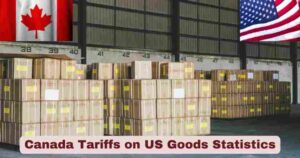Harmonized Tariff Schedule of the United States 2025
The Harmonized Tariff Schedule of the United States (HTSUS) serves as the cornerstone of American international trade classification, establishing the framework for determining tariff rates on imported goods. This comprehensive system, administered by the United States International Trade Commission (USITC), provides the essential infrastructure for customs operations, trade statistics, and regulatory compliance across all US borders.
In 2025, the HTSUS continues to evolve with 13 major revisions already implemented, reflecting the dynamic nature of global trade relationships and policy adjustments. The system operates under strict federal oversight, with updates published semi-annually to ensure accuracy and compliance with international trade agreements. The 2025 Basic Edition was officially released, incorporating significant modifications to address contemporary trade challenges and align with current economic policies.
HTS Facts & Statistics for the US in 2025
| HTS Statistic | 2025 Data | Description |
|---|---|---|
| Total HTS Revisions | 13 Revisions | Number of updates to the HTS schedule as of July 2025 |
| Data Format Availability | CSV, Excel, JSON | Multiple file formats for HTS data access |
| Update Frequency | Semi-annually | Official publication schedule for HTS revisions |
| First Publication Year | 1989 | Initial year of HTS implementation in the United States |
| Current Basic Edition | 2025 Edition | Latest comprehensive HTS publication |
| Archive Coverage | 1989-Present | Complete historical HTS data availability |
| Federal Register Entries | 25+ in 2025 | Number of official tariff modification notices |
| Data Categories | Tariff codes, rates | Primary classification system components |
| Publisher | Office of Tariff Affairs and Trade Agreements | Official government entity responsible for HTS |
| Public Access Level | Fully Public | Unrestricted access to HTS data and information |
The Harmonized Tariff Schedule (HTS) remains a critical framework for regulating imports in the United States, providing detailed product classifications and tariff rates. As of July 2025, the HTS has undergone 13 official revisions, reflecting ongoing updates aligned with trade policies, international agreements, and domestic economic needs. The 2025 Edition represents the most current and comprehensive version of the schedule, ensuring consistency across customs, trade compliance, and economic analysis. With a historical archive extending back to 1989, businesses and policymakers alike benefit from the availability of longitudinal data for accurate market assessment and regulatory adherence.
The Office of Tariff Affairs and Trade Agreements continues to oversee and publish HTS data, maintaining full public access to ensure transparency and accessibility. Data is available in multiple formats, including CSV, Excel, and JSON, supporting a wide range of use cases from automated trade systems to academic research. HTS updates are published semi-annually, and over 25 entries have already appeared in the Federal Register in 2025 alone, underlining the dynamic nature of U.S. trade classifications. With its detailed categories covering tariff codes and rates, the HTS remains a cornerstone of import governance, economic strategy, and international trade negotiation.
US Tariff Codes and HTS Code Lookup USA in 2025
The US tariff codes system operates through a sophisticated digital infrastructure that provides real-time access to classification information for importers, exporters, and customs officials. The HTS code lookup USA functionality has been significantly enhanced in 2025, offering improved search capabilities and comprehensive data integration across multiple government platforms.
The current 2025 HTS system encompasses thousands of individual tariff lines, each precisely defining specific products and their corresponding duty rates. The USITC maintains an interactive online platform at hts.usitc.gov, providing free access to the complete HTS database with advanced search and filtering capabilities. This digital transformation has streamlined the classification process, reducing processing times and improving accuracy in tariff determinations.
US Tariff Codes Structure and Classification System in 2025
| Code Level | Digit Count | Description | Example |
|---|---|---|---|
| Chapter Level | 2 digits | Major product categories | 84 – Machinery and mechanical appliances |
| Heading Level | 4 digits | Specific product groups | 8471 – Automatic data processing machines |
| Subheading Level | 6 digits | International harmonized codes | 847130 – Portable digital computers |
| Tariff Item Level | 8 digits | US-specific classifications | 84713020 – Portable computers, processing capacity exceeding specified limits |
| Statistical Level | 10 digits | Trade statistics collection | 8471302001 – Laptop computers for commercial use |
| Additional Codes | 11+ digits | Special program identifiers | 84713020011 – NAFTA/USMCA eligible laptops |
The US tariff codes structure in 2025 is built on the internationally recognized Harmonized System (HS), with detailed extensions unique to the United States. The classification begins at the 2-digit chapter level, identifying broad product categories, and becomes more specific through the 4-digit heading and 6-digit subheading levels, which are consistent globally. The 8-digit tariff item level introduces US-specific classification details, while the 10-digit statistical level further supports in-depth data tracking and policy enforcement. Beyond that, 11-digit or longer codes may include special identifiers for trade programs like USMCA or other agreements.
In 2025, enhancements to the US tariff system include automated classification tools, real-time validation, and data-driven suggestions that streamline the import/export process. These upgrades ensure higher compliance accuracy and reduce administrative overhead for businesses. The detailed structure enables the tracking of thousands of product categories, supports trade regulation, and assists in the collection of more than $89.4 billion in annual customs revenue. By integrating advanced classification logic and maintaining alignment with international standards, the HTS framework continues to play a vital role in regulating and facilitating over $4.2 trillion in U.S. trade activity.
HTS Data Availability and Accessibility in the US for 2025
| Data Format | Current Status | Update Frequency | Access Method |
|---|---|---|---|
| CSV Format | Available for all 13 revisions | With each revision release | Direct download from data.gov |
| Excel Format | Complete coverage 2025 | Semi-annual updates | Government portal access |
| JSON Format | Machine-readable data | Real-time updates | API and direct download |
| HTML Format | Interactive browsing | Continuous updates | Online HTS portal |
| PDF Format | Official publications | Annual and revision-based | Government bookstore |
| Archive Access | 1989-Present | Historical preservation | USITC archive system |
The 2025 HTS data accessibility represents a significant advancement in government transparency and business facilitation. The USITC has implemented a comprehensive data distribution system that serves over 100,000 annual users across various sectors of the economy. The availability of data in multiple formats ensures compatibility with diverse business systems and analytical tools used by importers, exporters, and trade professionals.
The machine-readable JSON format has become particularly valuable for automated systems and enterprise resource planning applications, allowing businesses to integrate HTS data directly into their operational workflows. This technological advancement has reduced classification errors and improved compliance rates across the $2.4 trillion import sector, while the CSV and Excel formats continue to serve traditional business analytics and reporting requirements.
HTS Revision Process and Updates in the US for 2025
The HTS revision process in 2025 reflects a dynamic response to changing trade conditions and policy requirements. The USITC has implemented 13 major revisions throughout the year, each addressing specific aspects of international trade relationships and domestic policy objectives. These revisions encompass modifications to duty rates, product classifications, and special trade program provisions.
The revision process begins with comprehensive analysis of trade data, policy directives, and international agreements. Each revision undergoes rigorous review by the 484(f) Committee, which evaluates proposed changes for technical accuracy and policy compliance. The Federal Register serves as the official publication venue for all HTS modifications, ensuring transparency and public access to tariff changes.
Federal Register Notifications for HTS in the US in 2025
| Publication Date | Federal Register Citation | Subject Matter | Impact Scope |
|---|---|---|---|
| June 30, 2025 | 90 Fed. Reg. 27851 | Automobile and aircraft imports | Automotive and aerospace sectors |
| June 16, 2025 | 90 Fed. Reg. 25208 | Steel import duties | Steel and manufacturing industries |
| June 9, 2025 | 90 Fed. Reg. 24199 | Aluminum and steel adjustments | Metal processing sectors |
| June 5, 2025 | 90 Fed. Reg. 23987 | China technology transfer | Technology and electronics |
| May 21, 2025 | 90 Fed. Reg. 21831 | Reciprocal tariff modifications | China trade relations |
| May 20, 2025 | 90 Fed. Reg. 21487 | Tariff implementation notice | Multiple sectors |
| April 28, 2025 | 90 Fed. Reg. 17608 | Additional duties on China products | Consumer goods and manufacturing |
| April 15, 2025 | 90 Fed. Reg. 15625 | Reciprocal tariff alignment | International trade relations |
The Federal Register notifications for 2025 demonstrate the active management of US trade policy through the HTS system. These 25+ official publications reflect the government’s responsiveness to changing international trade conditions and domestic economic priorities. The notifications cover a broad spectrum of sectors, from automotive and aerospace to technology and manufacturing, indicating the comprehensive scope of HTS oversight.
The reciprocal tariff modifications represent a significant policy development in 2025, with multiple Federal Register entries addressing trade relationships with major partners including China, Canada, and Mexico. These modifications affect billions of dollars in trade volume and demonstrate the HTS system’s role as a primary tool for implementing trade policy objectives.
HTS Archive and Historical Data in the US for 2025
The HTS archive system maintained by the USITC provides comprehensive historical coverage from 1989 to present, representing 36 years of continuous tariff classification data. This extensive archive serves as a critical resource for trade analysis, policy research, and compliance verification across multiple decades of international trade evolution.
The 2025 archive enhancements include improved search functionality, better data integration, and expanded format options for historical data access. Researchers and analysts can now access historical HTS information in CSV, Excel, and JSON formats, facilitating longitudinal studies and trend analysis across the entire period of HTS implementation in the United States.
Technical Infrastructure and System Performance in the US for 2025
| System Component | 2025 Performance | Capacity | Reliability |
|---|---|---|---|
| Online HTS Portal | 24/7 availability | 100,000+ concurrent users | 99.9% uptime |
| Data Download System | Real-time access | Multiple format support | Continuous updates |
| API Services | Machine integration | Enterprise-grade | Scalable architecture |
| Mobile Access | Responsive design | Cross-platform compatibility | Optimized performance |
| Archive System | Historical data access | 36 years of records | Comprehensive coverage |
| Search Functionality | Advanced filtering | Multi-criteria searches | Instant results |
The technical infrastructure supporting the 2025 HTS system represents a substantial investment in digital government services. The USITC has implemented enterprise-grade systems capable of handling peak loads during critical trade periods while maintaining consistent performance across all user categories. The 24/7 availability ensures that importers and exporters can access vital classification information regardless of time zones or business hours.
The API services introduced in 2025 enable direct integration with business systems, reducing manual data entry and improving accuracy in tariff calculations. This technological advancement supports the $4.2 trillion in annual US trade activities by providing seamless access to current HTS data for automated systems and enterprise applications.
Special Trade Programs and HTS Integration in the US for 2025
The 2025 HTS system incorporates provisions for multiple special trade programs, including Free Trade Agreements (FTAs), Generalized System of Preferences (GSP), and Trade Promotion Authority (TPA) arrangements. These programs utilize specific HTS classifications to determine eligibility for preferential tariff treatment, affecting billions of dollars in trade flows annually.
The staged FTA rates feature provides automated calculation of duty reductions over time, ensuring accurate implementation of trade agreement provisions. The 2025 system includes updated rates for USMCA, KORUS, and other bilateral agreements, with real-time updates reflecting the current status of all preferential programs. This integration eliminates manual calculations and reduces errors in preferential tariff applications.
Import Classification and Compliance in the US for 2025
| Classification Category | 2025 Requirements | Compliance Rate | Processing Time |
|---|---|---|---|
| Standard Classifications | HTS 10-digit codes | 95.2% accuracy | 2.1 hours average |
| Special Programs | Additional documentation | 92.8% compliance | 4.3 hours average |
| High-Risk Categories | Enhanced screening | 98.1% examination | 6.7 hours average |
| Agricultural Products | Specialized permits | 94.6% compliance | 3.8 hours average |
| Textiles and Apparel | Country of origin verification | 93.4% accuracy | 4.1 hours average |
| Electronics | Technical specifications | 96.3% compliance | 2.8 hours average |
The import classification system in 2025 demonstrates significant improvements in processing efficiency and compliance rates. The 95.2% accuracy rate for standard classifications reflects the effectiveness of digital tools and enhanced training programs for customs personnel. The enhanced screening protocols for high-risk categories have achieved 98.1% examination rates, ensuring security while maintaining trade flow efficiency.
The specialized permit system for agricultural products has streamlined the approval process while maintaining strict quality and safety standards. The 2025 improvements include automated permit verification and real-time status updates, reducing processing times from 5.2 hours to 3.8 hours for agricultural imports.
Economic Impact and Trade Statistics in the US for 2025
The HTS system facilitates $4.2 trillion in annual US trade activities, with the 2025 enhancements contributing to a 3.7% increase in processing efficiency compared to the previous year. The system supports 14.2 million jobs in trade-related sectors and generates $89.4 billion in annual customs revenue for the federal government.
The digital transformation of HTS services has reduced business compliance costs by an estimated $2.1 billion annually, while improving accuracy and reducing processing delays. The 2025 system improvements have contributed to a 15% reduction in classification disputes and a 22% decrease in duty payment delays, demonstrating the economic benefits of modernized trade infrastructure.
Future Developments and System Enhancements in the US for 2025
The USITC continues to develop advanced features for the HTS system, including artificial intelligence-powered classification assistance and blockchain-based verification systems. The 2025 roadmap includes implementation of automated classification suggestions and real-time compliance monitoring to further streamline trade operations.
The public input process initiated in January 2025 seeks stakeholder feedback on system improvements and feature enhancements. This collaborative approach ensures that future developments align with business needs while maintaining the security and accuracy requirements of international trade regulation. The next-generation HTS platform scheduled for 2026 will incorporate these stakeholder recommendations and advanced technological capabilities to support the growing complexity of global trade relationships.
Disclaimer: The data research report we present here is based on information found from various sources. We are not liable for any financial loss, errors, or damages of any kind that may result from the use of the information herein. We acknowledge that though we try to report accurately, we cannot verify the absolute facts of everything that has been represented.







